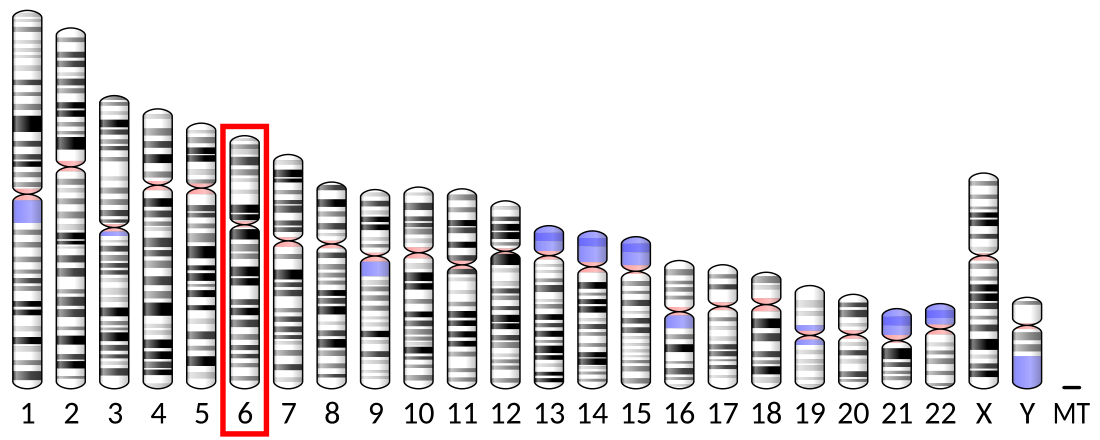Histone H1.1 is a protein that in humans is encoded by the HIST1H1A gene.[5][6][7]
Quick Facts H1-1, Identifiers ...
| H1-1 |
|---|
|
| Identifiers |
|---|
| Aliases | H1-1, H1.1, H1A, H1F1, HIST1, histone cluster 1, H1a, histone cluster 1 H1 family member a, H1.1 linker histone, cluster member, HIST1H1A |
|---|
| External IDs | OMIM: 142709; MGI: 1931523; HomoloGene: 134658; GeneCards: H1-1; OMA:H1-1 - orthologs |
|---|
|
|
|
|
|
| Wikidata |
|
Close
Histones are basic nuclear proteins responsible for nucleosome structure of the chromosomal fiber in eukaryotes. Two molecules of each of the four core histones (H2A, H2B, H3, and H4) form an octamer, around which approximately 146 bp of DNA is wrapped in repeating units, called nucleosomes. The linker histone, H1, interacts with linker DNA between nucleosomes and functions in the compaction of chromatin into higher order structures. This gene is intronless and encodes a member of the histone H1 family. Transcripts from this gene lack polyA tails but instead contain a palindromic termination element. This gene is found in the large histone gene cluster on chromosome 6.[7]
Eick S, Nicolai M, Mumberg D, Doenecke D (Sep 1989). "Human H1 histones: conserved and varied sequence elements in two H1 subtype genes". Eur J Cell Biol. 49 (1): 110–5. PMID 2759094.
- Du Clos TW, Zlock LT, Marnell L (1991). "Definition of a C-reactive protein binding determinant on histones". J. Biol. Chem. 266 (4): 2167–71. doi:10.1016/S0021-9258(18)52224-9. PMID 1989977.
- Gurley LR, Valdez JG, Buchanan JS (1996). "Characterization of the mitotic specific phosphorylation site of histone H1. Absence of a consensus sequence for the p34cdc2/cyclin B kinase". J. Biol. Chem. 270 (46): 27653–60. doi:10.1074/jbc.270.46.27653. PMID 7499230.
- Burfeind P, Hoyer-Fender S, Doenecke D, et al. (1995). "Expression and chromosomal mapping of the gene encoding the human histone H1.1". Hum. Genet. 94 (6): 633–9. doi:10.1007/bf00206957. PMID 7989039. S2CID 7185316.
- Albig W, Drabent B, Kunz J, et al. (1993). "All known human H1 histone genes except the H1(0) gene are clustered on chromosome 6". Genomics. 16 (3): 649–54. doi:10.1006/geno.1993.1243. PMID 8325638.
- O'Connor PM, Ferris DK, Pagano M, et al. (1993). "G2 delay induced by nitrogen mustard in human cells affects cyclin A/cdk2 and cyclin B1/cdc2-kinase complexes differently". J. Biol. Chem. 268 (11): 8298–308. doi:10.1016/S0021-9258(18)53096-9. PMID 8463339.
- Díaz-Jullien C, Pérez-Estévez A, Covelo G, Freire M (1996). "Prothymosin alpha binds histones in vitro and shows activity in nucleosome assembly assay". Biochim. Biophys. Acta. 1296 (2): 219–27. doi:10.1016/0167-4838(96)00072-6. PMID 8814229.
- Albig W, Kioschis P, Poustka A, et al. (1997). "Human histone gene organization: nonregular arrangement within a large cluster". Genomics. 40 (2): 314–22. doi:10.1006/geno.1996.4592. PMID 9119399.
- Meergans T, Albig W, Doenecke D (1998). "Conserved sequence elements in human main type-H1 histone gene promoters: their role in H1 gene expression". Eur. J. Biochem. 256 (2): 436–46. doi:10.1046/j.1432-1327.1998.2560436.x. PMID 9760185.
- Carrier F, Georgel PT, Pourquier P, et al. (1999). "Gadd45, a p53-Responsive Stress Protein, Modifies DNA Accessibility on Damaged Chromatin". Mol. Cell. Biol. 19 (3): 1673–85. doi:10.1128/MCB.19.3.1673. PMC 83961. PMID 10022855.
- Silljé HH, Takahashi K, Tanaka K, et al. (1999). "Mammalian homologues of the plant Tousled gene code for cell-cycle-regulated kinases with maximal activities linked to ongoing DNA replication". EMBO J. 18 (20): 5691–702. doi:10.1093/emboj/18.20.5691. PMC 1171636. PMID 10523312.
- Richardson RT, Batova IN, Widgren EE, et al. (2000). "Characterization of the histone H1-binding protein, NASP, as a cell cycle-regulated somatic protein". J. Biol. Chem. 275 (39): 30378–86. doi:10.1074/jbc.M003781200. PMID 10893414.
- Lever MA, Th'ng JP, Sun X, Hendzel MJ (2001). "Rapid exchange of histone H1.1 on chromatin in living human cells". Nature. 408 (6814): 873–6. doi:10.1038/35048603. PMID 11130728. S2CID 4416686.
- Chadwick BP, Willard HF (2001). "A Novel Chromatin Protein, Distantly Related to Histone H2a, Is Largely Excluded from the Inactive X Chromosome". J. Cell Biol. 152 (2): 375–84. doi:10.1083/jcb.152.2.375. PMC 2199617. PMID 11266453.
- Strausberg RL, Feingold EA, Grouse LH, et al. (2003). "Generation and initial analysis of more than 15,000 full-length human and mouse cDNA sequences". Proc. Natl. Acad. Sci. U.S.A. 99 (26): 16899–903. Bibcode:2002PNAS...9916899M. doi:10.1073/pnas.242603899. PMC 139241. PMID 12477932.
- Coleman MA, Miller KA, Beernink PT, et al. (2004). "Identification of chromatin-related protein interactions using protein microarrays". Proteomics. 3 (11): 2101–7. doi:10.1002/pmic.200300593. PMID 14595808. S2CID 23471253.
- Hendzel MJ, Lever MA, Crawford E, Th'ng JP (2004). "The C-terminal domain is the primary determinant of histone H1 binding to chromatin in vivo". J. Biol. Chem. 279 (19): 20028–34. doi:10.1074/jbc.M400070200. PMID 14985337.
- Cohen-Armon M, Visochek L, Katzoff A, et al. (2004). "Long-term memory requires polyADP-ribosylation". Science. 304 (5678): 1820–2. Bibcode:2004Sci...304.1820C. doi:10.1126/science.1096775. PMID 15205535. S2CID 20680175.
- Gerhard DS, Wagner L, Feingold EA, et al. (2004). "The Status, Quality, and Expansion of the NIH Full-Length cDNA Project: The Mammalian Gene Collection (MGC)". Genome Res. 14 (10B): 2121–7. doi:10.1101/gr.2596504. PMC 528928. PMID 15489334.





